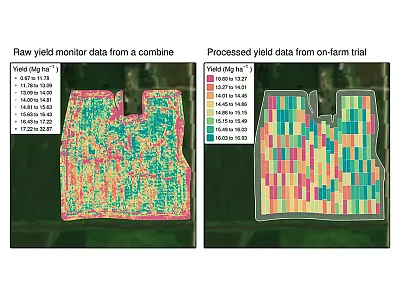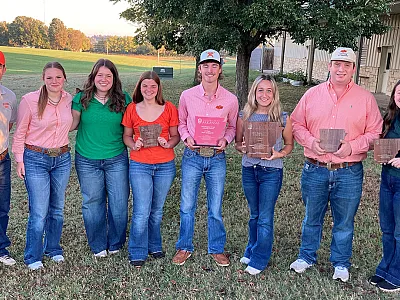Giant miscanthus shows promise as an alternative crop for marginal land
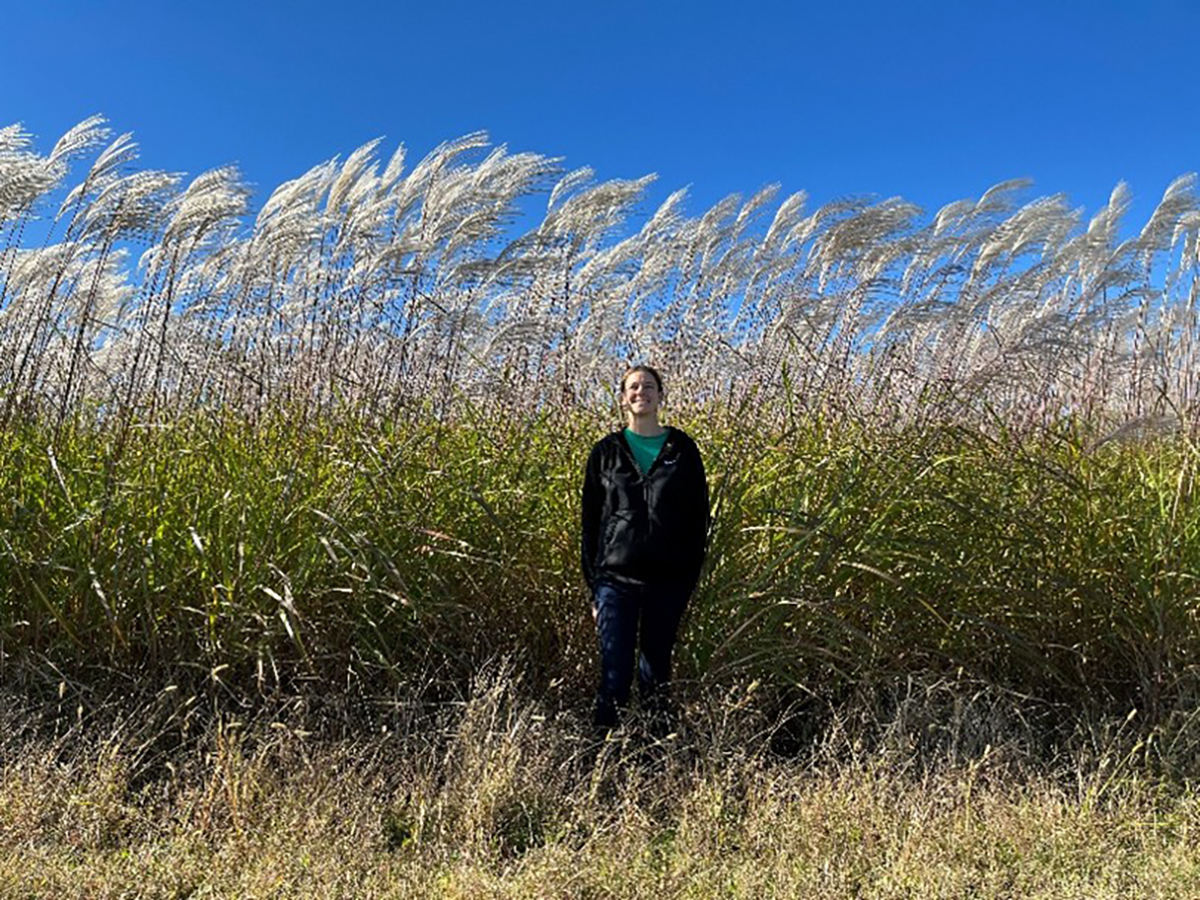

Giant miscanthus is a perennial, warm-season grass grown as a biomass crop. In Maryland, giant miscanthus successfully grew on marginal land experiencing flooding, saltwater intrusion, and heavy deer pressure, conditions that resulted in total soybean yield loss for several years prior to the study. While giant miscanthus did not grow in year-round flooded conditions and yield was negatively correlated with sodium level, giant miscanthus had little yield loss in areas with intermittent flooded conditions and areas with sodium levels well above what grain crops can tolerate. Earn 1 CEU in Crop Management by reading this article and taking the quiz.
Giant miscanthus (Miscanthus × giganteus) is a perennial warm-season grass that is grown as a biomass crop. It can grow 12 ft tall with roots up to 8 feet deep (Heaton et al., 2010; Neukirchen et al., 1999). Giant miscanthus reaches peak yield by Years 3 to 4 of growth, and its typical lifespan is 15 to 30 years. Yields typically range from 10 to 15 tons/ac and vary across regions and growing conditions (Heaton et al., 2010). Giant miscanthus is a sterile “triploid” hybrid resulting from a cross between Miscanthus sinensis (a diploid species) and Miscanthus sacchariflorus (a tetraploid species); therefore, it does not produce viable seeds (Williams & Douglas, 2011).
Giant miscanthus is planted via rhizome. Rhizome emergence results in a clump-like growth pattern. The clump originating from a rhizome spreads approximately 1 ft in diameter per year for the first three years. There is no evidence of giant miscanthus spreading aggressively via rhizome propagation like some species, such as johnsongrass (Sorghum halepense L.), and no evidence that it moves beyond its planted field boundaries except in cases of direct soil disturbance, such as rhizomes eroding off of a stream bank. However, giant miscanthus may be confused with other species of miscanthus that do spread via seed dispersal and can become invasive. These other species of miscanthus look almost identical to giant miscanthus and are often used in the landscape industry.
Giant miscanthus has a range of suitable growing conditions. It can be grown on different soil types from sandy soils to heavy clay soils but yields higher on soils with higher moisture retention such as clay soils (Richter et al., 2016). Soil pH should be between 5.5 and 7.5 (Caslin et al., 2015). For optimal yields, giant miscanthus should be grown in areas with at least 30 inches of rainfall per year (Williams & Douglas, 2011). Giant miscanthus can survive in a wide range of plant hardiness zones. In zones lower than four, giant miscanthus is prone to winter kill; in Zones 4 to 6, rhizomes should be planted in early spring after the last frost; in Zones 6 or higher, rhizomes can be planted in fall or spring. Soil temperatures should be above 50°F for emergence.
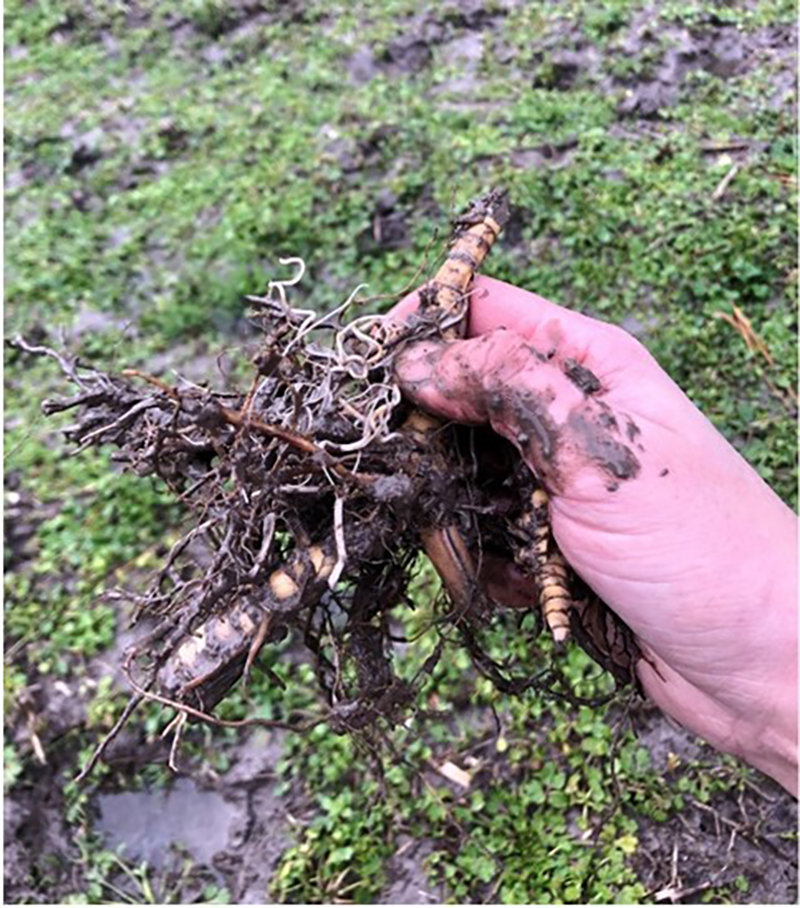
Giant miscanthus costs approximately $1000/ac to establish but has minimal management requirements post-planting (Jacobson, 2024). Rhizomes can be planted with a specialized rhizome planter or other equipment that deposits 2 to 4 inches of soil over the rhizomes and provides good soil to rhizome contact (Wilson & Heaton, 2013a). Giant miscanthus has low nutrient requirements. Nitrogen application is typically unnecessary in the first year of growth and can result in increased weed pressure (Caslin et al., 2015). While herbicides are recommended during the establishment phase (Years 1 to 2), giant miscanthus will outcompete weeds once it is established (Year 3) due to its dense and rigorous growth (Wilson & Heaton, 2013a, 2013b). Giant miscanthus has even been shown to outcompete phragmites (Phragmites australis) on marginal land.
Giant miscanthus dry biomass material is harvested once annually between November and March, after the stems have dried down and leaves have fallen. Standard forage or silage harvesting equipment such as choppers, mowers, and balers can be used. Harvested giant miscanthus material can be trucked directly to a buyer, stored in bulk (e.g., silage bags), or stored in bales. Because of the long harvest season and minimal management requirements, giant miscanthus can be a desirable additional crop for grain crop farmers facing limited time and resources. In Maryland, the primary current market for giant miscanthus biomass is poultry bedding, which functions the same as traditional pine chip bedding but is more sustainable. Giant miscanthus could also be grown for bioenergy markets or to use in fiber-based products, such as fuel pellets, fiberboard, or paper plates (Jacobson, 2024).
Environmental stressors on the Eastern Shore of Maryland
The Eastern Shore of Maryland faces several environmental pressures that force land out of grain production. The region falls within the Chesapeake Bay watershed and has an extensive coastline of waterways, which cause flooding and salt-water intrusion in crop fields. In addition, wildlife damage was cited as a significant farm challenge by 54% of Maryland farmers surveyed (534). It was cited as the second most significant farm challenge, falling right behind input costs (Dill et al., 2025). Deer damage often results in farmers replanting or abandoning grain crop fields. There are efforts in the region to repurpose abandoned cropland, for example, through conservation programs. However, often fields are simply abandoned and become overrun with invasive weeds, such as phragmites. Farmers express a desire to continue growing cash crops on marginal land facing these environmental stressors. However, they struggle to find alternative crops that will grow in the marginal conditions and that they can successfully market.
Can giant miscanthus grow on marginal land?
The current research project began as a collaboration between University of Maryland Extension and a Maryland farmer seeking an alternative crop on part of his property. The land had been in soybean production but had total crop failure during the previous three years. Through a Northeast Sustainable Agriculture Research and Education “Partnership Grant”, we were able to investigate the potential for giant miscanthus to grow on this marginal land facing flooding, saltwater intrusion, and intense deer pressure. Our research questions included:
Will giant miscanthus emerge and grow in land facing flooding, saltwater intrusion, and deer pressure?
How will giant miscanthus biomass yield on such marginal land compared with prime land?
We conducted the research on a 10-ac field in Dorchester County, Maryland. The field had poorly drained Elkton silt loam and moderately well-drained Mattapex silt loam soils with 0–2% slopes (Soil Survey Staff, 2025). The field was planted in June 2022. We were able to monitor the field from June 2022 to July 2024. In July 2024, the property changed hands, and we were not able to continue monitoring.
The 10-ac field was divided into 20- x 0.5-acre subdivisions (Figure 1). We evaluated the conditions of each subdivision in terms of soil conditions (e.g., pH and organic matter) and sodium (Na) level. Within the 20 subdivisions, we flagged off quadrats of 1 m2. We evaluated stand count, height, and Year 1 and Year 2 yields within these quadrats. We also measured soil conditions (e.g., pH and organic matter) and Na level. We measured soil moisture continuously for five depths (3, 6, 12, 18, and 32 inches) within five of these quadrats. We were cost-inhibited from measuring soil moisture in all 20 quadrats; however, we selected the five areas because they ranged in the degree of flooding they experienced.
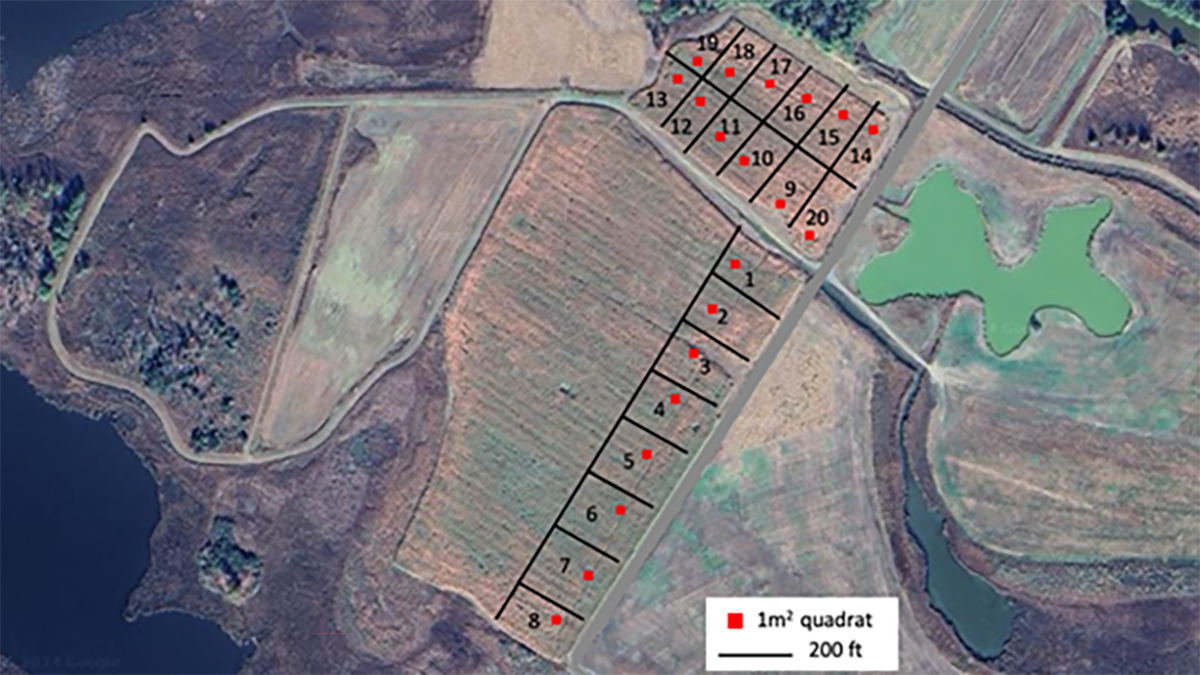
We monitored deer presence with a wildlife camera installed at the edge of the field-bordering forest (edge of Plot 19). We also walked the field multiple times during the growing season to scout for deer grazing on giant miscanthus.
Giant miscanthus shows great potential on marginal land
Across the 0.5-ac field subdivisions, soil Na ranged from 120 to 620 ppm Na with an average of 317 ppm Na, pH from 5.6 to 6.2 with an average of 5.8, and OM from 2.1 to 3% with an average of 2.6%. Within the 1 m2 quadrats, soil Na ranged from 57 to 510 ppm Na with an average of 174 ppm Na. These Na values are considered high as a typical tolerable level for Na in Delmarva row crop land is 5 to 40 ppm (University of Delaware, 2024). The field experienced intermittent flooding, and the majority of the field was flooded during most of the winter. There was a range of soil moisture patterns across the five areas monitored. In all five areas, soil moisture probes buried at the 32-inch depth stayed saturated year-round, indicative of a high water table. However, soil moisture probes located closer to the surface stayed saturated year-round in one area, but in the other four areas, dried out to different degrees between precipitation events.
We found a heavy deer presence in the giant miscanthus field. During the giant miscanthus emergence and establishment period (June through July 2022), the wildlife camera captured 29 to 31 deer per week. Later in the first growing season during the giant miscanthus dry-down period (October through December), the wildlife camera captured 12 to 62 deer per week (Figure 2). However, giant miscanthus did not experience deer damage due to grazing. We observed a few deer paths and areas where they bedded down, but these were not large enough areas to negatively influence yield. We observed no significant weed, insect, or disease pressures in the giant miscanthus field. No form of pesticide was applied.
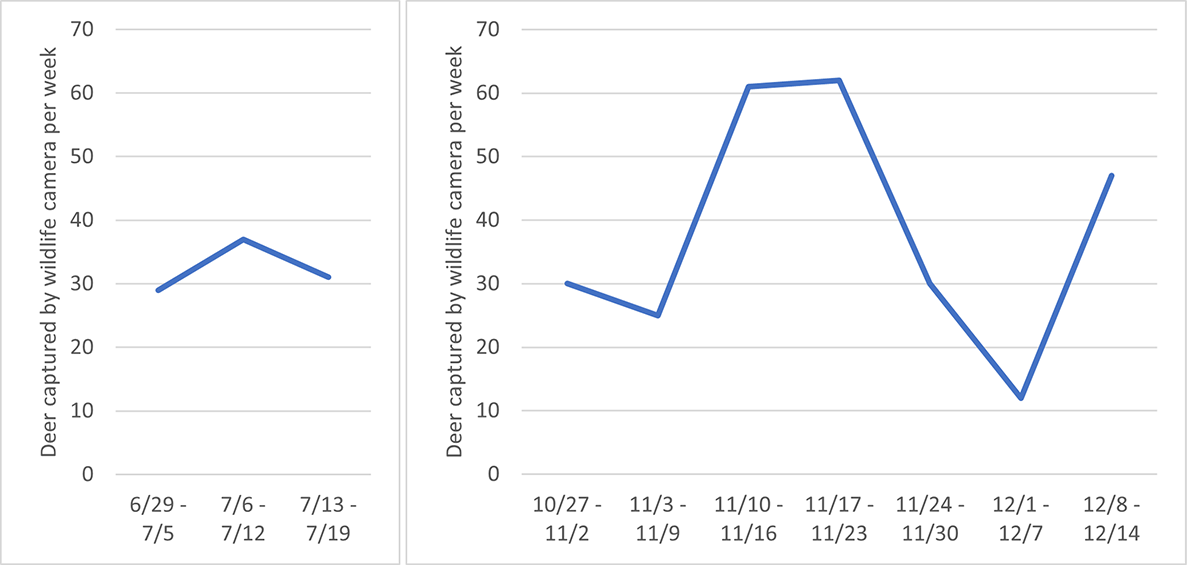
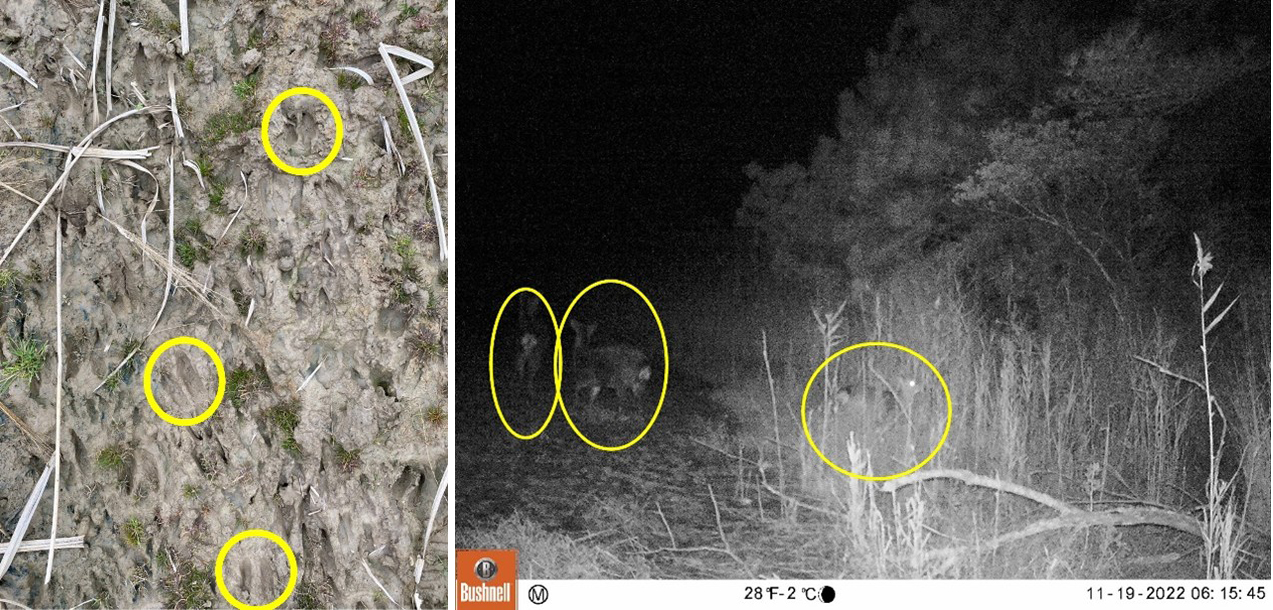
The average biomass yield was 2.8 tons/ac in the first year and 4.8 tons/ac in the second year. These yields were lower than yields on prime land as typical first- and second-year yields on prime land in the area are 2.5 to 3 tons/ac and 6 tons/ac, respectively (personal communication with grower). The giant miscanthus was able to tolerate the elevated Na levels, albeit there tended to be a yield penalty. The giant miscanthus yield was negatively correlated with Na levels (Figure 3). Despite the yield penalty, it is noteworthy that the giant miscanthus survived and had harvestable yield. This is contrary to the farmer’s experience growing soybean at this site, which had no harvestable yield due to the marginal field conditions.
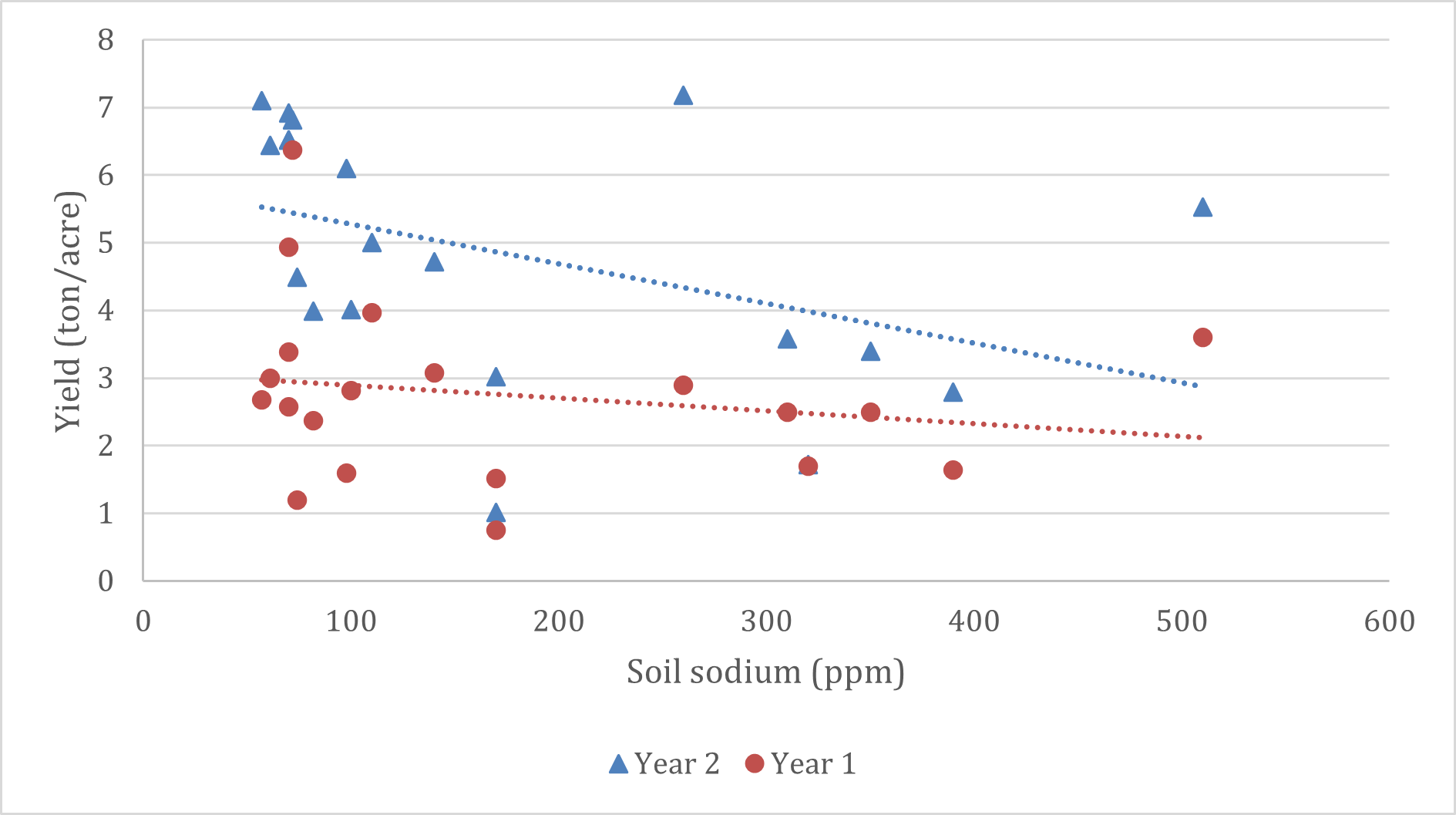
The tolerance of giant miscanthus to flooding was also promising. We found that giant miscanthus grew well in areas with intermittent flooding and areas that held water for periods of several weeks. The only area of the field with total yield loss was the area flooded nearly year-round.

Interest in the agriculture community and beyond
The giant miscanthus field trial site also served as an outdoor classroom. Twenty-nine farmers, agriculture service providers, and policymakers attended a public field day to observe giant miscanthus growing on marginal land. We have presented information on giant miscanthus to an additional 798 attendees at workshops, presentations, and webinars. We are also currently engaging in discussions with government departments and private companies about opportunities to initiate or expand giant miscanthus markets in the region.

Takeaways for practitioners
Giant miscanthus survives and can produce reduced, but marketable, yields on land experiencing flooding and saltwater intrusion.
Giant miscanthus can grow in deer-infested areas without experiencing noticeable damage.
We do not recommend farmers grow giant miscanthus without first securing a buyer or market. Currently there is an active poultry bedding market in Maryland for giant miscanthus, and other markets are being developed.
Giant miscanthus has a high start-up cost, compared with grain crops, but after establishment, requires minimal inputs.
Giant miscanthus requires less effort than annual crops because it only requires replanting every 15 to 20+ years.
Giant miscanthus does not compete with harvest windows of grain crops because dry biomass can be harvested during a long window over the winter (from November to March in Maryland).
Based on observations from multiple planting sites, for fields prone to flooding, we recommend planting giant miscanthus in the spring rather than fall. When rhizomes were planted in the fall and the field flooded during winter, the rhizomes appeared to rot, and the field experienced a poor stand.
Prolonged periods of flooding will not only decrease yields, but can inhibit the ability for farmers to get planting and harvesting equipment in the field.
Acknowledgments
This material is based upon work supported by the National Institute of Food and Agriculture, USDA, through the Northeast Sustainable Agriculture Research and Education program under subaward number ONE21-392. Any opinions, findings, conclusions, or recommendations expressed in this publication are those of the authors and do not necessarily reflect the view of USDA.
Caslin, B., Finnan, J., & Johnston, C. (Eds.). (2015). Miscanthus best practice guidelines. Teagasc and the Agri-Food and Bioscience Institute.
Dill, S., Hirsh, S., Newton, S., Kumar, H., Vollmer, K., Fiorellino, N., & Kness, A. (2025). University of Maryland Extension winter meeting data 2023–2024 (FS-2024-0744). University of Maryland Extension. go.umd.edu/FS-2024-0744
Heaton, E., Moore, K., Salas-Fernandez, M., Hartzler, B. Liebman, M., & Barnhart, S. (2010). Giant miscanthus for biomass production (AG201). Iowa State University. https://store.extension.iastate.edu/product/12611
Jacobson, M. (2024). Energy crop profile: Giant miscanthus. Penn State Extension. https://extension.psu.edu/energy-crop-profile-giant-miscanthus
Neukirchen, D., Himken, M., Lammel, J., Czypionka-Krause, U., & Olfs, H.-W. (1999). Spatial and temporal distribution of the root system and root nutrient content of an established Miscanthus crop. European Journal of Agronomy, 11, 301–309.
Richter, G. M., Agostini, F., Barker, A., Costomiris, D., & Qi, A. (2016). Assessing on-farm productivity of Miscanthus crops by combining soil mapping, yield modeling and remote sensing. Biomass and Bioenergy, 85, 252–261.
Soil Survey Staff. (2025). Web Soil Survey. USDA-NRCS. https://websoilsurvey.nrcs.usda.gov/app/
University of Delaware (2024). Delmarva saltwater intrusion. Agriculture and salt issues. sites.udel.edu/delmarvasalt/home-page/agriculture-and-salt-issues.
Williams, M. J., & Douglas, J. (2011) Planting and managing giant miscanthus as a biomass energy crop (Technical Note No. 4). USDA NRCS Plant Materials Program. https://www.nrcs.usda.gov/plantmaterials/flpmstn10548.pdf
Wilson, D., & Heaton, E. (2013a). Giant miscanthus establishment (PM3056). Iowa State University. https://store.extension.iastate.edu/product/14006
Wilson, D., & Heaton, E. (2013b). Giant miscanthus weed control. Iowa State (PM3055). Iowa State University. https://store.extension.iastate.edu/product/Giant-Miscanthus-Weed-Control
Self-study CEU quiz
Earn 1 CEU in Crop Management by taking the quiz for the article. For your convenience, the quiz is printed below. The CEU can be purchased individually, or you can access as part of your Online Classroom Subscription.
Giant miscanthus, a robust, drought-tolerant plant, can grow well in areas with as little as 15 inches of annual rainfall.
a. True.
b. False.
Producers of giant miscanthus in ideal growing conditions can expect a yield of ___ in Year 2.
a. 3 tons/acre.
b. 4 tons/acre.
c. 5 tons/acre.
d. 6 tons/acre.
Deer grazing was estimated to reduce giant miscanthus yield by
a. 0%.
b. 1–5%.
c. 6–10%.
d. more than 10%.
In a field experiencing continuous winter flooding, the authors recommend planting giant miscanthus in the fall.
a. True.
b. False.
Giant miscanthus is propagated via
a. seeds.
b. slips.
c. rhizomes.
d. transplants.
What is the ploidy level of giant miscanthus that prevents it from producing viable seeds?
a. Diploid.
b. Triploid.
c. Tetrapoid.
d. Hexaploid.
Giant miscanthus will emerge once soil temperature reaches
a. 32° F.
b. 40° F.
c. 50° F.
d. 60° F.
The typical lifespan of giant miscanthus is
a. 1 year.
b. 2 years.
c. 5 years.
d. 15–30 years.
Maryland research found that giant miscanthus was tolerant to the following environmental stressor:
a. Salt-water intrusion.
b. pH < 5.
c. Year-round flooding.
d. All of the above.
The following is a potential market for giant miscanthus:
a. Poultry bedding.
b. Bioenergy.
c. Fiberboard.
d. All of the above.
Text © . The authors. CC BY-NC-ND 4.0. Except where otherwise noted, images are subject to copyright. Any reuse without express permission from the copyright owner is prohibited.




